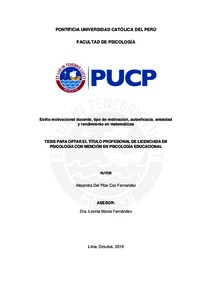| dc.contributor.advisor | Matos Fernández, Lennia | es_ES |
| dc.contributor.author | Coz Fernández, Alejandra del Pilar | es_ES |
| dc.date.accessioned | 2019-11-11T21:01:59Z | es_ES |
| dc.date.available | 2019-11-11T21:01:59Z | es_ES |
| dc.date.created | 2019 | es_ES |
| dc.date.issued | 2019-11-11 | es_ES |
| dc.identifier.uri | http://hdl.handle.net/20.500.12404/15349 | |
| dc.description.abstract | A pesar del valor que posee el aprendizaje de las matemáticas para el desarrollo del
pensamiento formal, existe una tendencia de dificultades por parte de los estudiantes en los
niveles básicos de la escuela para aplicar este conocimiento. A partir de ello, la presente
investigación explora desde la Teoría de la Autodeterminación, las relaciones entre el estilo
motivacional docente de apoyo a la autonomía y de control percibido por los estudiantes, los
tipos de motivación autónoma y controlada, la autoeficacia, la ansiedad y el rendimiento en
matemáticas en 302 estudiantes de cuarto y quinto grado de primaria de una institución
educativa privada de Lima, seleccionados de manera intencional. Además, este estudio
examina las propiedades psicométricas de los instrumentos utilizados, las diferencias según
sexo respecto a la autoeficacia y la ansiedad, y las diferencias en las variables del estudio según
la agrupación por rendimiento de los estudiantes. Los resultados indican adecuadas evidencias
de validez y confiabilidad de los instrumentos en la muestra. El análisis de correlaciones
permite proceder con el análisis de senderos, en el cual se halla que la percepción de apoyo a
la autonomía docente predice de manera positiva e indirecta el rendimiento en matemáticas,
mediado por la motivación autónoma y la autoeficacia. Por otro lado, se encuentra que la
percepción de control docente predice de manera negativa e indirecta el rendimiento en
matemáticas, mediado por la motivación controlada y la autoeficacia. No se encuentran
diferencias significativas según el sexo para la autoeficacia y la ansiedad. Se hallan diferencias
significativas entre los estudiantes de los grupos más altos y más bajos de rendimiento para la
percepción de control docente, la motivación controlada, la autoeficacia y la ansiedad. Los
resultados se discuten en relación a las tendencias del lado claro y el lado oscuro de la
motivación hacia las matemáticas. | es_ES |
| dc.description.abstract | Despite the value that learning mathematics has for the development of formal thought, there
is a tendency of difficulties by students in basic school levels to apply this knowledge. Based
on this, this study explores from Self-Determination Theory the relationships between teacher’s
autonomy supportive and controlling style perceived by students, autonomous and controlled
types of motivation, self-efficacy, anxiety and performance in mathematics in 302 fourth and
fifth grade primary students from a private educational institution in Lima, intentionally
selected. In addition, this study examines the psychometric properties of the instruments used,
the differences according to sex with respect to self-efficacy and anxiety, and the differences
in the variables of the study according to the grouping by student performance. The results
indicate adequate evidence of validity and reliability of the instruments in the sample. The
analysis of correlations allows us to proceed with the path analysis, in which it is found that
the perception of teacher’s autonomy support predicts in a positive and indirect way the
performance in mathematics, mediated by autonomous motivation and self-efficacy. On the
other hand, it is found that the perception of controlling teaching predicts in a negative and
indirect way the performance in mathematics, mediated by controlled motivation and selfefficacy.
No significant differences are found according to sex for self-efficacy and anxiety.
Significant differences are found between the students in the highest and lowest performance
groups for the perception of teacher control, controlled motivation, self-efficacy and anxiety.
The results are discussed in relation to the trends of the bright side and the dark side of
motivation towards mathematics. | es_ES |
| dc.language.iso | spa | es_ES |
| dc.publisher | Pontificia Universidad Católica del Perú | es_ES |
| dc.rights | info:eu-repo/semantics/openAccess | es_ES |
| dc.rights.uri | http://creativecommons.org/licenses/by/2.5/pe/ | * |
| dc.subject | Matemáticas--Estudio y enseñanza (Primaria) | es_ES |
| dc.subject | Motivación (Educación) | es_ES |
| dc.subject | Rendimiento académico | es_ES |
| dc.title | Estilo motivacional docente, tipo de motivación, autoeficacia, ansiedad y rendimiento en matemáticas | es_ES |
| dc.type | info:eu-repo/semantics/bachelorThesis | es_ES |
| thesis.degree.name | Licenciada en Psicología con mención en Psicología Educacional | es_ES |
| thesis.degree.level | Título Profesional | es_ES |
| thesis.degree.grantor | Pontificia Universidad Católica del Perú. Facultad de Psicología | es_ES |
| thesis.degree.discipline | Psicología con mención en Psicología Educacional | es_ES |
| renati.discipline | 313046 | es_ES |
| renati.level | https://purl.org/pe-repo/renati/level#tituloProfesional | es_ES |
| renati.type | http://purl.org/pe-repo/renati/type#tesis | es_ES |
| dc.publisher.country | PE | es_ES |
| dc.subject.ocde | http://purl.org/pe-repo/ocde/ford#5.01.00 | es_ES |






